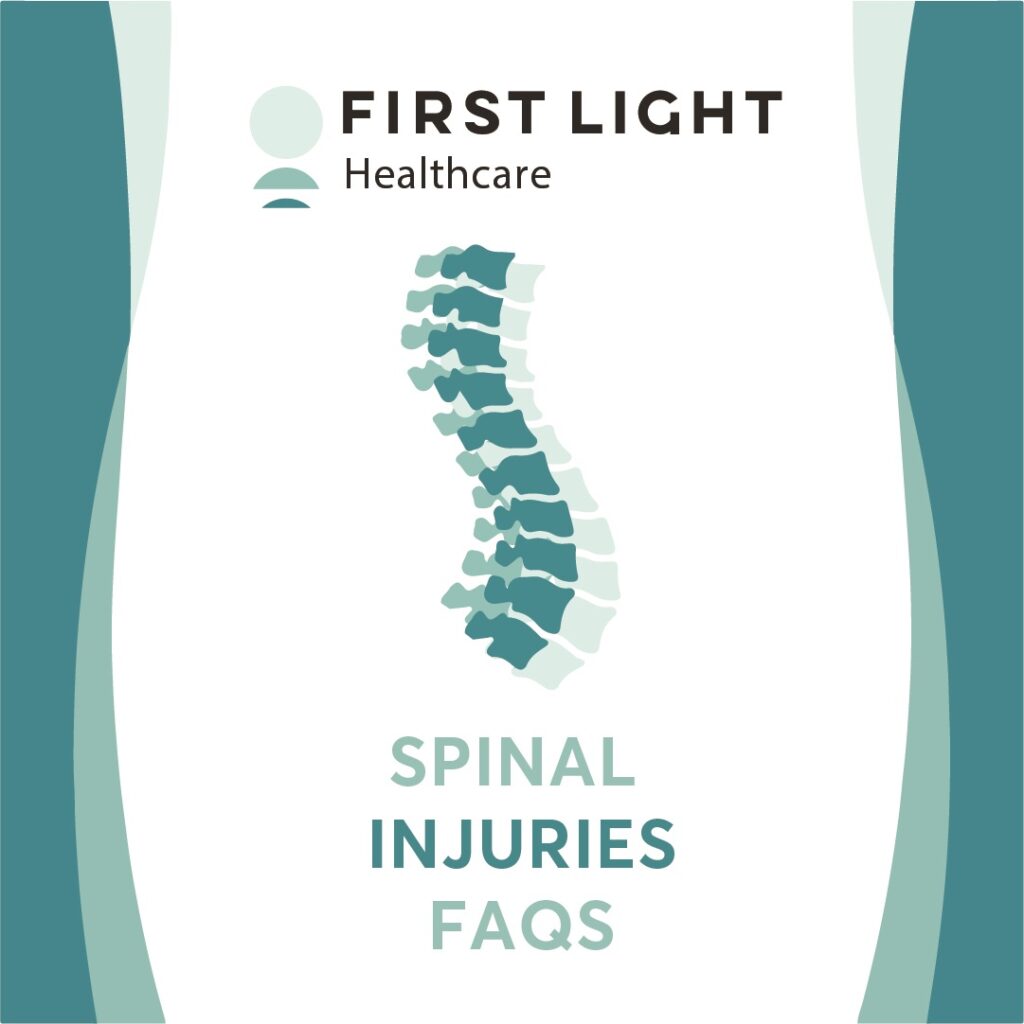SPINAL INJURIES FAQ’S
The spine is what holds us together and keeps us upright, it is quite literally the backbone of our body. Looking after the health of your spine can contribute to our overall wellbeing, conversely, spinal injuries can greatly impact our life, depending on the severity. Below are some of the most frequently asked questions about what makes up our spine and the various types of spinal injuries and treatments.

What Exactly is the Spine?
The spine is made up of a long series of bones that surround the spinal cord, known as the vertebral column. The vertebral column is made up four parts. The neck is the called the cervical spine, the thoracic spine is the middle and upper back section of the spine. The lumbar is the lower spine, and the sacral region is located above the tailbone at the base of the spine.
The spine importantly protects the spinal cord, which is a series of encased nerves that travel down the middle of the back and connect to the brain. Trauma to the spine can occur to only the bones that surround the spinal cord or in some cases, it can cause injury to the spinal cord – the nerves that send messages to parts of the body and control movement as well as organ and other bodily functions.
How Many Spinal Bones are There?
The average person is born with 33 individual bones (the vertebrae) that interact and connect with each other through flexible joints called facets. By the time a person becomes an adult most have only 24 vertebrae because some vertebrae at the bottom end of the spine fuse together during normal growth and development.
The spinal canal is the tunnel that houses and protects the spinal cord and nerves, especially from injury. Most vertebrae can move to allow for a range of body motion however, the lowest vertebrae (the sacrum and coccyx) are fused together and don’t move. The cervical section of the spine is made up of the upper top seven vertebrae in the spine and is connected to the base of the skull.
What is the Spinal Cord?
The spinal cord and the brain make up the central nervous system. The spinal cord is made up of connected nerve tissue that runs down from the base of the skull to the centre of the back and is covered by protective tissue called membranes. The spinal cord and membranes are surrounded by the vertebrae.
What Does the Spinal Cord Do?
The spinal cord connects your brain to your lower back and vitally carries the all-important nerve signals from your brain to your body as well as back from the brain to the body. These nerve signals help you feel sensations and allows you to intentionally move your body, while also allowing your body to naturally react to your environment, such as sweating when you are hot.
Because the spinal cord sends and receives important information about your body and its surroundings it is vital to the regulation of bodily functions, including: ******
- Regulating heart rate.
- Assessing temperature, and helping your body appropriately respond to cool or warm itself when temperatures are inappropriate.
- Maintaining homeostasis—relatively consistent internal body conditions. By sending signals about the body’s state, the spinal cord allows the brain to react with signals that initiate a cascade of changes. For example, if the spinal cord sends signals to the brain indicating that you are cold, you may begin shivering or seek out a blanket.
- Regulating breathing.
What are the Different Types of Spinal Injuries?
Our spine goes through stress every day to ensure we can stand upright and move freely. Despite its strength and flexibility, our spines are not invincible, and especially over time, spines can develop injuries and conditions that compromise its functionality and can be the cause of discomfort and pain. It is estimated that four million Australians (16% of the total population) have back pain and problems. ***
Back problems can have many causes. These can relate to work, sport and lifestyle issues and diseases including arthritis, disc disease and osteoporosis. But often back pain is the result of an injury.
Common Types of Back Injuries
- Sprains and strains
- A herniated or bulging disc
- Fractured vertebra.
While there are many types of fractures and dislocations that can happen to the spine, the two main types of injuries to the spinal bones (the vertebrae) are fractures and dislocations. A fracture is a break to any part of the vertebrae. A dislocation is when the vertebrae do not line up correctly or are out of place. Both types of injuries can lead to damage to the spinal cord. ***
What is Spinal Cord Injury?
Spinal cord Injury is very different from back injuries such as ruptured disks or pinched nerves. If the spinal cord is damaged it can potentially cause the loss of function, feeling and mobility. Spinal cord injuries are most frequently caused by traumas including car accidents, falls, a violent incident or a sports-related injury. Sports-related spinal cord injuries typically occur most often in children and teenagers, while work-related injuries such as from a construction work accident are more common in adults.
It is important to know that if a person ‘breaks’ their neck or back they may not necessarily sustain a spinal cord injury. For those individuals they may not experience paralysis if the bone damage is successfully treated, often with surgery. It is important to know that spinal cord injury only occurs if the spinal cord is damaged.
The spinal cord however does not need to be severed for a loss of functioning to occur. In fact, for most people with a spinal cord injury, the spinal cord remains intact, but the damage that results in a loss of function is caused by compression or bruising from the injury.
Depending on the severity of the trauma, a spinal cord injury can cause the permanent loss of strength, sensation and function below the site of the injury. These spinal cord injuries can result in paralysis including paraplegia (a loss of function below the chest) and quadriplegia (a loss of function below the neck). **
What is the Difference Between a Complete or Incomplete Spinal Cord Injury?
A spinal cord injury is often referred to as either a complete or incomplete spinal cord injury (SCI). For a complete spinal cord injury to occur there are no signals between the spine and the brain below the point of injury and therefore, there is no sensation or voluntary movement.
A person with an incomplete SCI injury may be able to move one limb more than they can move another. They may feel parts of their body, but they cannot move it, or there may be more functioning evident on one side of the body than the other side.
Other effects of spinal cord injury can include low blood pressure, or the inability to regulate blood pressure effectively. A spinal cord injury can also reduce the control of body temperature and the inability to sweat below the level of injury, and chronic pain may be present. *
How Do You Treat a Spinal Injury?
Rehabilitation and assistive devices can allow many people with spinal cord injuries to lead productive, independent lives. Treatments for spinal injuries can include medication to help reduce any symptoms, while in some cases surgery can also help to stabilise the spine. Other options can include soft neck collars and various back braces.
With some spinal injuries, surgery may also be necessary to remove any fragments of bones, foreign objects, herniated disks or fractured vertebrae that may be compressing or impacting the spine. Surgery may also be required to stabilise the spine to prevent current or future pain or deformity forming.
How Do You Treat a Spinal Cord Injury?
With spinal cord injuries, most recovery occurs within the first three to six months following the injury, however in some cases, recovery can continue for many months, sometimes even years after the injury occurred. Physical rehabilitation and consistently practicing movements that have been affected from the injury, plus other prescribed activities can also be helpful.
For spinal cord injuries, there are unfortunately no known ways at present to reverse the damage to a spinal cord. However, researchers are continually working on new treatments, including prostheses and medications, which in some cases may promote the regeneration of nerve cells or improve the function of the nerves that remain after a spinal cord injury.
The treatments currently available for spinal cord injuries typically focus on preventing any further injury while aiming to empower people to return to an active and productive life. **
When is Spinal Fusion Necessary?
Spinal fusion surgery aims to permanently connect two or more vertebrae in the spine to improve stability, correct a deformity or reduce pain from a spinal injury. Spinal fusion surgery can help correct spinal deformities, such as a sideways curvature of the spine (scoliosis). Typically, spinal fusion surgery is not recommended until a patient has tried six months to a year of non-surgical care. *
[BREAKOUT BOX]
What Do You Do if You Suspect Someone Has Injured their Spine?
If you suspect someone has injured their spine, or if a person who has sustained a head injury, they may also have also injured their spine and you therefore need to treat the injured person with care. In elderly people especially, the force required to cause a neck injury is much less than in younger people. For older people, a spinal injury can even occur from a standing height fall.
It is important to keep the injured person’s head in line with their neck. Avoid twisting their head or allowing their head to roll to the side. If you can, roll a t-shirt, towel or similar soft item and place it around their neck to keep their head straight. Don’t try to move them unless there is an urgent requirement to do so. ****
Signs and symptoms of spinal injuries may include:
- The body lying in an awkward, unnatural position
- Their skin feeling clammy and cool
- Reporting unusual tingling sensations in the limbs or an absence of any sensation, including an inability to feel pain
- An inability to move their limbs
Sources:
*https://scia.org.au/
**https://www.healthdirect.gov.au/spinal-cord-injuries
*** https://www.aihw.gov.au/reports/chronic-musculoskeletal-conditions/back-problems/contents/what-are-back-problems
**** https://www.betterhealth.vic.gov.au/health/conditionsandtreatments/head-and-spinal-injuries-first-aid#spinal-injuries
***** https://www.nichd.nih.gov/health/topics/spinalinjury/conditioninfo/treatments
******https://www.spinalcord.com/blog/what-does-the-spinal-cord-do
By Tracey Hordern
Reviewed by the First Light Healthcare team


